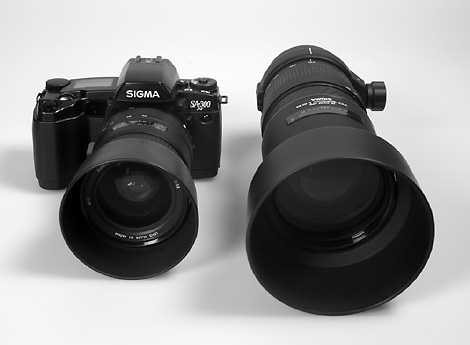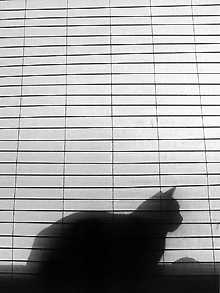
 With all the cutting edge technology that has been shoehorned into mass
market and professional SLRs over the last couple of decades it has become
pretty easy for the average camera user to become overawed, to the extent
that many have forgotten the basic fact that it is the lens which is the
most important part of the image creating process - not the camera body.
With all the cutting edge technology that has been shoehorned into mass
market and professional SLRs over the last couple of decades it has become
pretty easy for the average camera user to become overawed, to the extent
that many have forgotten the basic fact that it is the lens which is the
most important part of the image creating process - not the camera body.This point was most eloquently made by an independent lens manufacturer in the mid-1980s, by running an ad showing a photograph taken using one of their zoom lenses and a shoe box. But the point seems to have been largely missed and the buying public are now merrily putting their camera bodies in front of their lenses more than ever before.
This has now come to a head with the average all singing, all dancing, Japanese camera body costing, say, �500 - with about �120 worth of all plastic bottle casually slung on the front.
Sigma, on the other hand, have been putting lenses in front of bodies for donkey's years - most notably other manufacturer's bodies. In the 1990s "independent lens" isn't the dirty word it used to be. Top of the range Sigma, Tamron, Tokina ATX and Vivitar Series 1 have - after a hard uphill slog - managed to allay the prejudices of all but the most pedantically � litist photographers and can now be found in many a professional camera bag. I have even noticed a couple of situations where the balance has flipped completely - a Minolta fit Tokina 300mm f4 Apo costs a tad more than the "genuine" article.
Anyway, to the point. A few years ago Sigma took the brave step into the body market with their SA-300 with its own Sigma SAF mount. 'Brave" because of the impending arrival of APS (which has been on the cards for some time now within the industry) and because of the widely held view that 'the last thing we need now is another new mount" - Canon and Minolta (twice now in the latter case) having alienated their existing users with an incompatible new mount.
The latest incarnation of the SA-300 is the SA-300n - "n" simply standing for "new" in camera label engineering.
The SA-300n offers an impressive feature list for a �389.95 (rrp) body. Yes, there are more important aspects to a camera than its features list but I expect someone wants to know so: 3 fps integral winder, variable auto bracketing (missing on some bodies twice the price), matrix, average and 'spot" metering, the usual array of exposure modes (including fully shiftable program), GN11 pop up flash with wireless flash modes using the EF-430, mirror-up mode (almost unique), depth of field preview (also missing on all but a tiny handful of AF SLRs), databack, 30 sec to 1/4,000 shutter with 1/125 flash sync, user adjustable and DX ISO setting, and multiple AF modes. Phew!


Above right:"It's sometimes a little hard to get any scanning done with Bob
around"; SA-300n with 28-70mm and pop-up flash at close quarters and in dim
light. Focus and exposure were perfect despite the far from normal
circumstances. The shadow in the foreground is a drawback of using large
lenses with pop-up flash at close quaters.
Above: A series of shots of a
blind revealed faultless geometry on the 28-70mm. These damn cats get
everywhere.
In terms of control layout the SA-300n bears more than a passing resemblance to the lower and mid echelons of the Canon EOS range, and indeed, these are most likely to be its most fierce competitors. The design is a little 'blocky' for a 90s camera, but is not unattractive despite this. Shutter and aperture are controlled by twin thumb wheels in the usual positions. I personally found the front one rather badly placed for my large hands, but those with smaller fingers will probably find it quite manageable. Similarly the shape of the grip was not to my liking, and I did not feel I had an adequately secure grasp of the camera at times.
The selector wheel on the left side of the body was far more satisfactory. It provides easy access to the exposure modes and a few other features. There are separate buttons for adjusting metering patterns, flash modes and exposure compensation nearby and, while they could have been included on the wheel to reduce the button count, they are more quickly accessible where they are - which shows that the designers have kept the needs of the serious user in mind.
The pop up flash is a little on the puny side at GN11, but did give accurate results even when used on taxing subjects and at close focusing distances.
Focusing was not as lightning fast or quiet as many other second generation autofocus SLRs, but, despite its single central sensor, it did prove very accurate and free from the continual hunting and poor low light performance that has characterised other manufacturers early attempts. It would certainly pass muster for most subjects other than fast sports photography.
There is an AE lock button which is difficult to actuate, but this does not pose a problem as a half pressure on the shutter button stores the exposure reading until released - a useful feature especially in spot metering mode. The spot area itself is a little large for my liking but, as the camera is intended for mass market as well as serious use, this is less likely to incur exposure errors with the less experienced user.
The SA-300n is an exceptionally light and fairly compact piece of kit, yet still feels of a quality comparable to any other sub-�400 camera.

We laid our hands on two serious bundles of glass and metal (yes, metal, remember that old fashioned stuff) the Sigma 28-70mm f2.8 and 70-210mm f 2.8 Apo.
Of the two, the �760 70-210mm Apo looks the most impressive. The lens is solid and well balanced with the light SA-300n body and focuses nicely in MF mode. Many similar 80-200mm f2.8s are bulkier and lack that useful 10mm of range at each end. My only gripes with the handling are that the zoom ring on mine was a mite sticky at the short end, and that the AF/MF collar was not as positive as it might be. The optical performance in field tests was good, outperforming the resolution of the film, which tends to be the limiting factor in such cases anyway. Lens flare was negligible even under extreme conditions.
I'm often asked what 'apo" means (or APO as most manufacturers incorrectly write it) so those who already know must bear with me for a second. Normal lenses are designed to focus a single wavelength - usually blue - of light on the film plane whereas apochromatically corrected designs are optimised to focus red, green and blue wavelengths on the same plane. That's right - apochromats are sharper. However, don't fall into the trap of thinking you don't need an apo lens because you only shoot black and white - unless you're still using that old box of orthochromatic plates'
Potential buyers of long fast zooms should be aware of their limiting factors. The most important of these is limited close focusing ability which hinders their use as portrait lenses - the Sigma for example only manages a minimum of 1.8m. The other drawback is that they require king size filters, and I'm not talking about cigarettes! Longer lenses enjoy small rear fitting or slot-in filters but the Sigma is stuck with wallet crushing - and hard to find - 82mm ones. But don't even think about skimping on your skylight filter with a lens of this quality and price, unless you're the type that puts remoulds on your Porsche'
Initially the 28-70mm f2.8 looks like a standard plastic affair but on closer examination it too has be metallically manufactured from the lens mount to the filter ring, and only the fairly mundane finish makes it look more run of the mill. It too performed impressively, but fell prey to lens flare when really put on the spot. Aside from this it makes for an ideal pro quality standard zoom, leaving 35-70mm designs behind for sheer practicality in every day use.
Although there is no macro label, the 28-70 will focus down to a useful 50cm - almost as good as a standard 50mm lens. Again it has a large filter ring but at least the 72mm size is more readily available than the 82mm - although it does rotate while focusing.
Minor quibbles though, as for the �370 asking price this lens is a real steal.
Thanks to their metal mounts and the SAF central mounting point, these lenses are very quick to remove and attach - probably more so than any other make - which is a feature which should never be overlooked as more shots are missed while changing lenses that for any other reason.
Both these lenses had one disconcerting feature - they need refocusing to an appreciable degree if you change focal length, even when focusing at the long end and pulling back to a shorter focal length. But at half the price of marque designs, these pro class Sigma optics just cannot be ignored.
The SA-300n is also better suited to lightweight kit requirements. The only drawback is that buyers will, somewhat paradoxically, be locked into the Sigma range of lenses, at least for the present time - whether we will see other independents making SAF mount lenses remains to be seen.
Having said this, with the optical quality we have seen from these lenses this cannot really be seen as any real disadvantage.
Some of you might have wondered what has happened to the much mooted Sigma SA-500 which was supposedly hot on the heels of the 300n.
The word on the street is that Sigma have decided to pay a little extra attention to the focusing speed before launching a more expensive variant - and quite right they are too, as the stakes are higher above the �450 mark and buyers are more demanding. I reckon that if they can speed things up in the focusing department and tweak the ergonomics in the right direction, they'll have a sure-fire winner on their hands.
-Andy Aitken
Return to Photon July 96 contents